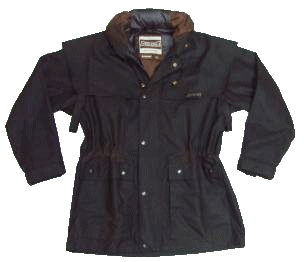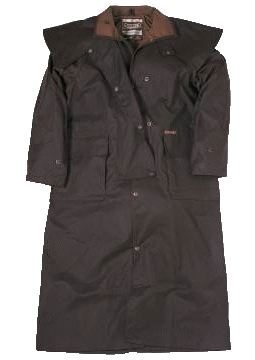
About Australia
Australian Foods, Gifts and Souvenirs
401 Isom Rd, Suite 500, San Antonio, Texas, 78216, USA
Phone 210-299-1077, Fax 210-541-6755
www.about-australia-shop.com
| DRIZA-BONE OILSKIN JACKETS & COATS |
 |
 |
Buy Driza-Bone Coats and other Australian Goods (Click Here)
The DRIZA-BONE LEGACY
|
The Driza-Bone oilskin coat has been a part of
Australian life since 1898. For over a hundred years the Driza-Bone has
been essential to the lives of many; stockmen, horse riders, sporting
teams and spectators, royalty, celebrities, as well as ordinary rural and
urban folk who have an appreciation of the great outdoors. In the 1890's, a Scottish sailor named Edward Le Roy who voyaged across the great southern oceans, discovered that the torn sails on his ship could be recycled into long coats and sou'westers (a seaman's weather-proof hat) by painting the canvas material with a mixture of oils. This transformed them into excellent wet weather gear. The word on the land spread about the effectiveness of Le Roy's coats in the wet and Australia's squatters and settlers soon adopted them. The coat was adapted to life on the land by adding a fantail to protect the seat of the horse rider's saddle, leg straps to keep the coat from taking off in strong winds, and extra-long sleeves to protect the wearer when his arms were extended. The coats were so effective and useful for many, that they eventually became known as Driza-Bones, named after the dried and scorched bones of animals in the arid Australian Outback. The theory that oil and water don't like to mix still keeps out the heaviest downpours of rain, even when you need to be outdoors for days on end. Certain improvements have been made to the secret oiling process of the Driza-Bone over the last century, but the coat's essential style, waterproof quality and famous durability remain unchanged. Today, Driza-Bone has evolved from being solely an oilskin work coat, to an internationally recognised brand that encompasses a wide range of coats, jackets, vests, hats and leather goods used for both working and outdoor recreational activities. This not only reflects the heritage of the Driza-Bone, but also adds a smart modern look to what has become an Australian icon. |
CARING FOR YOUR OILSKIN DRIZA-BONE
|
The oil-based proofing of Oilskin Driza-Bone coats is
very durable in the wet, so cleaning your Oilskin coat is quite simple to
do. However, cold water should be used at all times, so as to minimise the
amount of proofing that is removed during cleaning. Even if you intend on
re-proofing your Oilskin coat, only wash it with pure soap in lukewarm
water. Remove dry soil, sand, grit etc. with a soft clothes brush and sponge with cold water. To remove heavier soiling, hang up your coat and hose or rinse in cold water. Once cleaned, place your coat on a hanger to dry naturally away from heat. When completely dry, store in a cool dry place. DO NOT use soap unless you plan to re-proof your coat. DO NOT use detergent, bleach or any other cleaning agent. DO NOT wring, spin, or tumble dry. DO NOT iron. DO NOT dry clean. DO NOT expose to high temperature heat sources or any form of ignition! DO NOT stitch through the outer fabric, should this be necessary, then re-proof the area with original Driza-Bone garment dressing. Use only original Driza-Bone proofing compound as substitutes could harm the garment. How often your Driza-Bone garment will need proofing depends on the amount and type of use it will get. To maintain it's long service, monthly checks are suggested to ensure that there are no 'dry' areas where proofing has been worn away. Pay particular attention to critical areas such as shoulders, neck seams, and areas subject to friction, like pockets, creases in sleeves and knees. PRECAUTION: Do be careful to ensure that the essential proofing does not mark other clothing or fabric, particularly in unlined areas of the garment. |
Buy Driza-Bone Coats and other Australian Goods (Click Here)
Privacy Policy

About Australia
Australian Foods, Gifts and Souvenirs
401 Isom Rd, Suite 500, San Antonio, Texas, 78216, USA
Phone 210-299-1077, Fax 210-541-6755
www.about-australia-shop.com